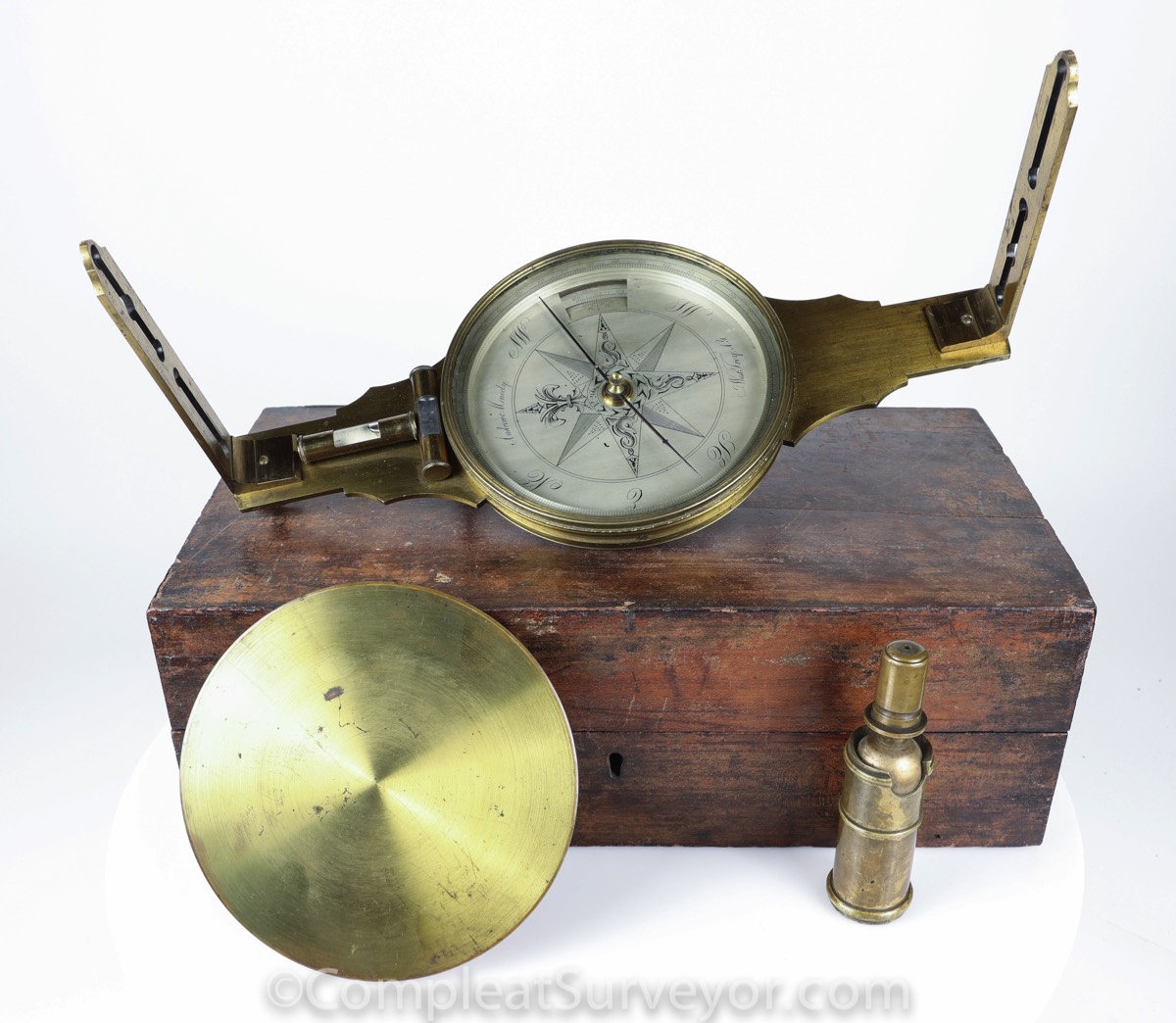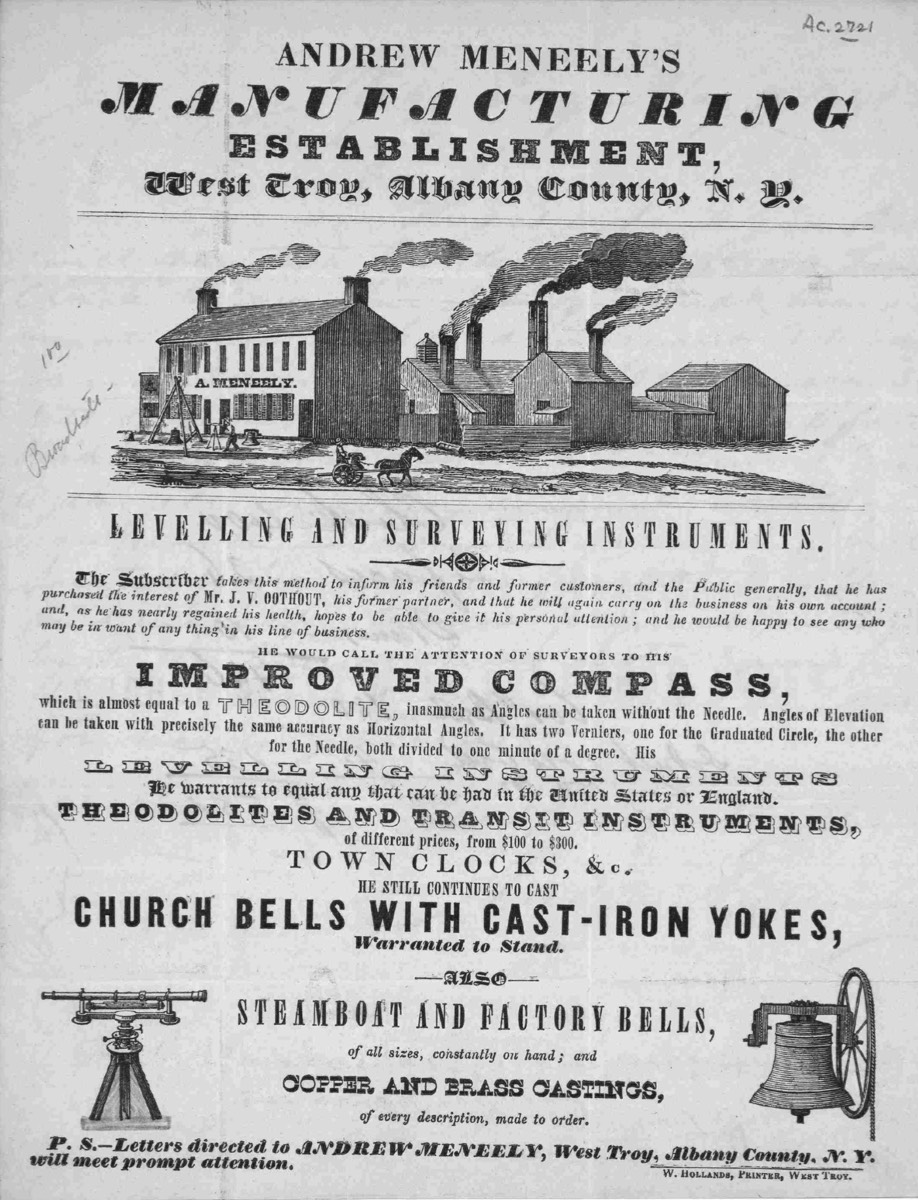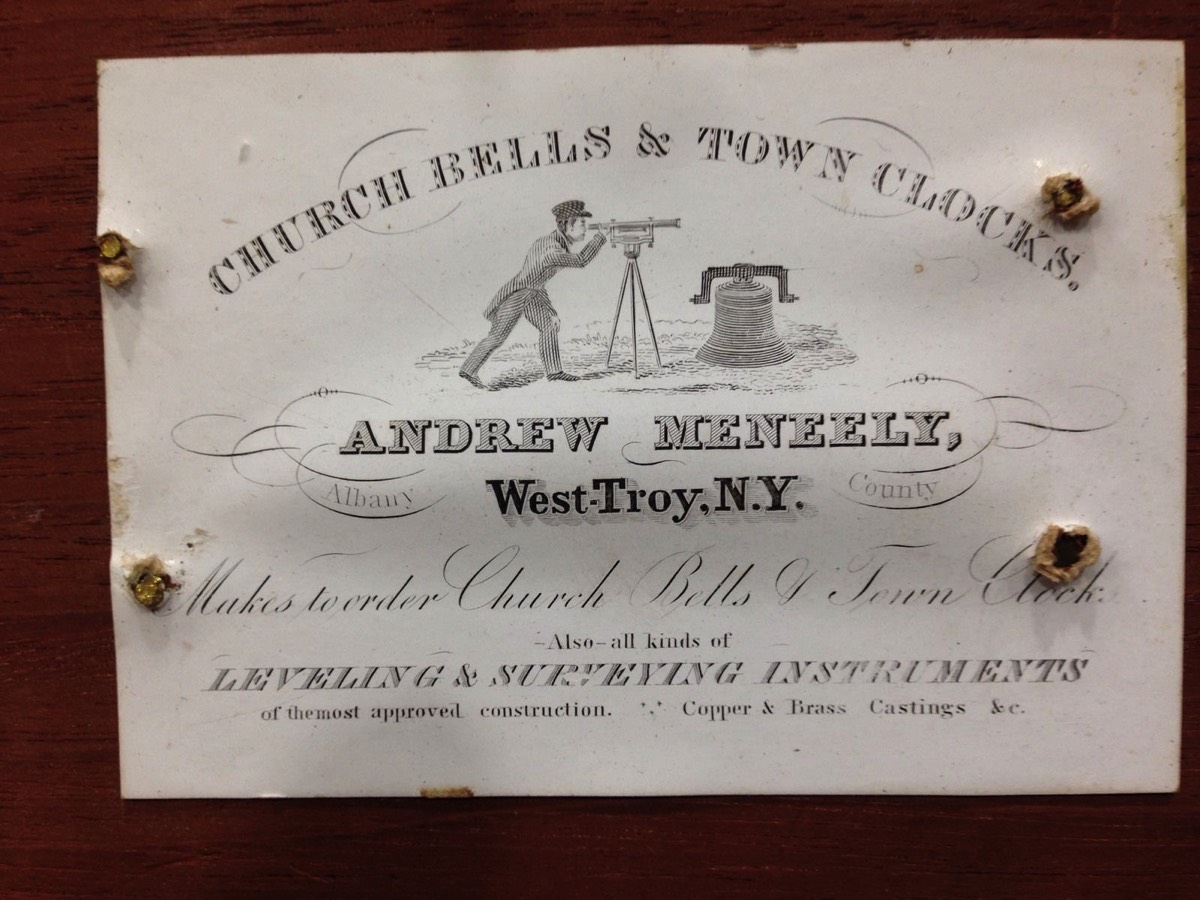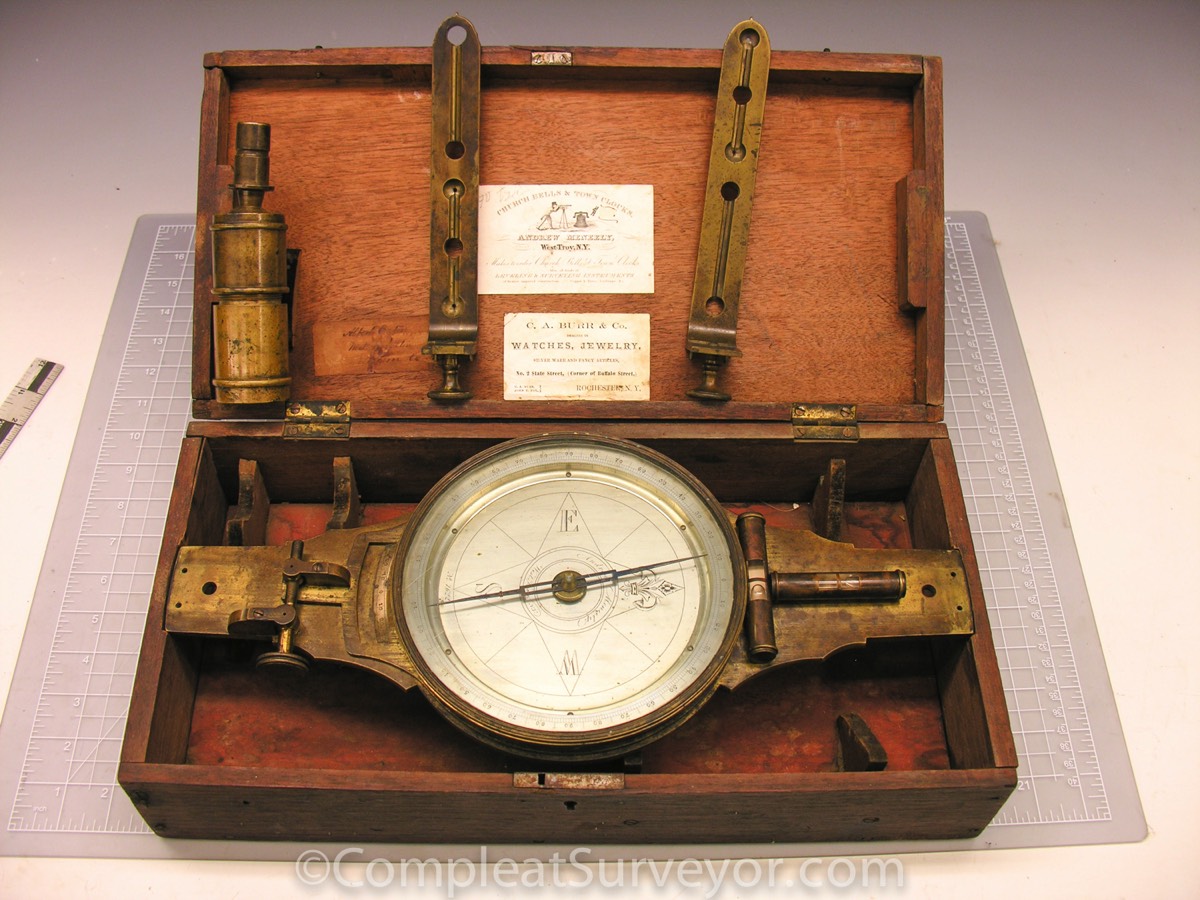
Andrew Meneely & Family
History
Andrew Meneely
1802-1851
Andrew Meneely, followed by his sons, established a successful survey instrument making business in Troy, NY and were part of a group of makers that flourished there from the early 19th century to the latter part of the 20th century. Andrew Meneely was one of a group of mathematical instrument makers, related by apprenticeship and often marriage. Beginning in 1808 with Col. Benjamin Hanks and ending in 1980 with Teledyne Gurley, they produced a body of work related by design elements and reflecting their mutual associations and common influences.
Andrew Meneely (Jr) was born on May 19, 1802, to Andrew and Eleanor (Cobb) Meneely, who had emigrated from Ireland to Gibbonsville (later West Troy) in 1795. At 16 or thereabouts, Andrew entered the Gibbonsville shop of Julius Hanks (as J. Hanks), son of its founder. At the age of 15 or 16 he apprenticed under Julius Hanks of West Troy to learn the trade of casting bells and manufacturing mathematical instruments; he learned bell casting, clock making, and the manufacture of surveying instruments. Having made the brief acquaintance of another apprentice, Horatio Hanks, a brother of Julius, he relocated to Auburn, NY in 1823 to join Horatio's business there. Auburn was fortuitously located along the route of the Erie Canal, then under construction, where Horatio intended to supply the local markets with bells and surveying instruments. Upon the completion of the canal, the two separately returned to the Troy area. Andrew, while in Auburn, had made the acquaintance of Philena Hanks, Horatio's cousin and daughter of Rodney Hanks, Col. Benjamin Hanks' younger brother. In 1826 they were married in Mansfield, Conn. near the Hanks homestead.
In 1825 Julius Hanks acquired some land in the City or Troy, across the Hudson River from Gibbonsville, and built a shop and foundry. Andrew seized upon this opportunity and, in 1826, moved into the old J. Hanks shop and began competing with his former employer. In 1831 he advertised:
ANDREW MENEELY
Makes to order, and keeps constantly on hand. the above Instruments on the most approved construction. He would call attention of Surveyors to his Improved Compass, which is almost equal to the Theodolite. inasmuch as Angles can be taken without the Needle. Angles of elevation can be taken directly with precisely the same accuracy as horizontal angles. It has two verniers, one for the graduated circle the other for the needle, both of which are divided to one minute of a degree. His Leveling Instruments he warrants to be equal to any that can be had in the United States or England. Theodolites of various prices, from $75 to $200. TOWN CLOCKS AND BRASS EIGHT DAY CLOCKS FOR HOUSES.
He still continues to cast
CHURCH BELLS
Of Superior tone, with Cast Iron Yokes, and warranted to stand. Also, Steam-Boat and Factory Bells of all sizes continuously on hand. Copper and Brass CASTINGS of every description.
In 1836, Andrew's frail health forced him to take on a partner to help him run the business. He chose Jonas Volkert Oothout his foreman, and on January 1, 1836 the firm became Meneely & Oothout. Jonas Oothout was born in West Troy, New York in 1814 and died there in 1860. For a few years the business was carried on under the firm name of Meneely & Oothout. Mr. Oothout retired in 1838 and Andrew Meneely continued the business as formerly. In 1841 Andrew, having sufficiently regained his health, purchased Oothout's share and reclaimed sole proprietorship, changing the name back to Andrew Meneely.
In 1850 Andrew's eldest son. Edwin A. was made manager and the company became Andrew Meneely & Son. Andrew died shortly thereafter on October 14, 1851 at the age of 49. He left his widow, Philena, and three sons: Edwin Andrew, then 23, George Rodney, 20, and Clinton Hanks, 12, Edwin and George, being old enough to run the business, changed the name to Andrew Meneely's Sons.
Early Period Instruments (1826-1836)
Andrew Meneely may have been making surveying instruments as early as 1826 and, from the early advertising, considered it a major part of the business. The instruments made before 1836, when the company became Meneely & Oothout, were marked A. Meneely, Gibbonsville, in small letters on the compass face. During the latter part of that period, "West Troy" replaced "Gibbonsville". Even though the Village of West Troy was not incorporated until 1836, the name had entered the vernacular, at least by 1831. The only instruments seen from this earliest period are surveyors compasses. These have similarly shaped main plates, flat-topped knobs with fine knurling in double rows, and sight vanes with tops shaped like Dutch roof lines. They are fined into walnut boxes with chamfered slide-tops. Compass faces display an overall plainness, but with a fine large fleurs-de-lis at North. Compass rings are divided into whole degrees with every fifth division extended vertically down the inside of the ring. Needles are narrow bars, sometimes carrying a thin silver vernier. During this same period, Julius Hanks (as J. Hanks) was making compasses with similarly shaped main plates. His flat-topped knobs also have double-row knurling but with a much more pronounced bead. The sight vanes also have tops that closely resemble Meneely's. Compass rings are similarly divided into whole degrees with the divisions extended vertically down the inside of the ring (Figure 6b). Occasionally every degree division is extended and sometimes only the divisions every 90°. Early J. Hanks needles are also narrow bars, sometimes carrying silver verniers, but occasionally have additional decorative elements. In 1831, Julius was granted a patent for bow sights and needles fitted with slide weights. After that date, all Hanks (J. Hanks and O. Hanks) compasses have the slide weight needle. It is noteworthy that Julius Hanks' compass faces are typically much more elaborately engraved than the early period A. Meneely faces.
Meneely & Oothout Instruments (1836-1841 )
Many decorative and design elements noted in the early period persisted into the Meneely & Oothout years and beyond, including the shaped main plate and sight vanes and the vertically-extended compass ring divisions. The engraving on compass faces became much more elaborate and, from 1836 to 1838, compass faces were dated. During 1838, serial numbers were added, sometimes with and sometimes without engraved dates. During the latter part of 1838 and through 1841, serial numbers appeared on every compass face. Throughout the Meneely & Oothout years, "Warranted" appears on compass faces, echoing advertisements that the instruments were warranted. Magnetic needles bifurcated in their middle 2 inches first appear during the later Meneely & Oothout years. This distinctive design persisted through the succeeding periods. Railroad compasses and wye levels seem to appear during these years. There are no known railroad compasses, wye levels, or theodolites from the Early Period, in spite of their being advertised in the Troy area.
Use of the term "railroad" was apparently initiated by Phelps & Gurley and applied to compasses with horizontal limbs that enable horizontal angles to be turned without reference to the magnetic needle. Surfaces between the plates on these railroad compasses are sometimes scratched with names and dates. There are two known which bear the name James Meneely, Andrew's brother, who was in the brass hardware business. Clearly he was pressed into service when needed.
Similarities found with J. Hanks compasses in the Early Period continue with O. Hanks compasses (1834-1845) during the Meneely & Oothout years. Vertical compass ring divisions are also found on Jonas H. Phelps compasses (1838-1845). Phelps had apprenticed with Julius and Oscar Hanks until 1838.
Andrew Meneely (1841-1850)
During this period compass face engraving becomes somewhat less elaborate. Variations in main-plate shape are found during this time, but sight vanes remain unchanged. It appears, from the instruments that I have had an opportunity to examine, that the majority of all Meneely instruments were made during this period. It was also during this time that the O. Hanks shop closed (1845) and Phelps & Gurley was formed (1845-1851). William Gurley, too had apprenticed with Oscar Hanks. The only Meneely transits known were made during this period. They have well made compasses and plates and fine leveling heads, but rather primitive (simple) optical systems. Meneely telescopes are very similar to the telescopes of both O. Hanks and Phelps & Gurley.
Andrew Meneely & Son (1850-1851) - There are no known instruments marked with this name.
Andrew Mcneely's Sons (1851-?)
With the death of Andrew Meneely there also died an interest in making surveying instruments, particularly in light of the full-scale competition gearing lip across the Hudson at the Gurley enterprise. Early in 1852, W. &. L. E. Gurley moved into the old O. Hanks shop and erected a four-story factory building divided into departments. By mass producing high quality surveying instruments, Gurley intended to undercut all American competition. Edwin and George must have understood how the competitive landscape was about to change and responded appropriately. They refocused their efforts onto their strength: bronze bell casting. In 1852 they produced an advertising letter sheet shouting: "CHURCH BELLS", that demonstrated this shift. Of the 11 inches of text and pictures, approximately one inch in the bottom third of the page refers to surveying instruments. Contrast this with a similar advertising letter sheet printed in 1841-2, that emphasizes surveying instruments and does not mention bells until the bottom quarter of the sheet. In 1856, Andrew Meneely's Sons issued their first catalog. There is no mention of surveying instruments at all. A letter from W. & L. E. Gurley, sent in 1868, mentions that, "Meneely has not been in the Instrument business for many years.
Existent examples of instruments marked "Andrew' Meneely's Sons" fall into two distinct groups (the only known are compasses): those made by Meneely and those made by Gurley. The Meneely-made compasses are similar to those with the "Andrew Meneely" mark (1841-1850) and may represent orders taken prior to, or at about the time of, Andrew's death. The Gurley-made compasses are typical in every respect, of Gurley and incorporate no Meneely design elements. Andrew Meneely's Sons (later E. A. & G. R. Meneely, and Meneely & Co.) prospered as a bell foundry. Andrew's youngest son, Clinton H., returning after serving in the Civil War, began his own bell foundry in Troy as Meneely & Kimberly (later the Clinton H. Meneely Bell Co. and the Meneely Bell Company). Both companies continued until 1952, both suffering from the evaporation of the market for tower bells.
The Meneely foundry in West Troy is one of the most significant bell foundries in the New World. To the citizens of Troy, NY, the name "Meneely" is synonymous with bells; and so it should naturally be since about half the bells in America carry that name. It was founded in 1826 and went out of business in 1952. The records of the firm are at the New York State Library in Albany, and a finding aid for that collection is available. During their history, they made about 75,000 bells. There's an amateur historian in town named Gene Burns who has tracked down about 8,000 of the ones that have survived to the present. There was another Meneely bell foundry across the river from them, located at 22 River Street here in Troy. It came about because of a family feud. Andrew Meneely, the founder of the West Troy firm, had three sons. Before he died in his 40s, he had brought the oldest one into the firm. That son brought in the second-oldest after his father died, but the third son went off to fight in the Civil War. When he returned in the late 1860s, the two other brothers wouldn't let him into the business, so he crossed the river in a huff and started his own firm. That firm made about 25,000 bells, including the replacement for the Liberty Bell that hangs to this day in Independence Hall in Philadelphia.
Andrew Meneely - Serial Numbers
From what I can tell, Andrew Meneely was a prolific maker of surveying instruments, and I found newspaper advertisements from Vermont and Louisiana, suggesting that Meneely made many instruments and sold them over a large geographic area. Meneely started putting serial numbers on his instruments sometime between 1826 and 1836. Here are some data points that I could find (assuming Meneely numbered his instruments consecutively):
Andrew Meneely (1826 thru 1836)
Low of #237
High of #313
Meneely & Oothout (1836 thru 1841)
Low of #551
High of #976
Andrew Meneely (1841 thru 1850)
Low of #1020
High of #1626
Andrew Meneely & Son (1850 thru 1851)
No Data Points
Andrew Meneely's Sons (1851 - ?)
#5112
National Museum of American History:
Vernier Compass
Poster From Library of Congress (shown below)
1841 Poster

Labels


Additional Pictures


© 2020 Russ Uzes/Contact Me

